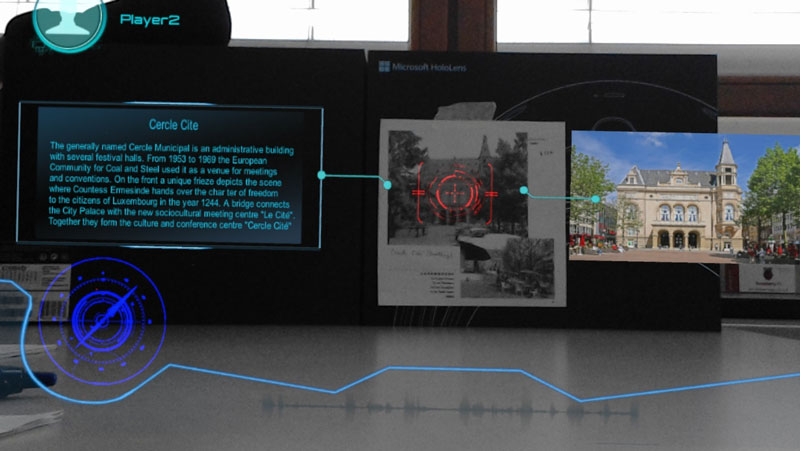by Thomas Tamisier, Irene Gironacci and Roderick McCall (Luxembourg Institute of Science and Technology)
The Locale project proposes a vision of location-aware digital storytelling empowered by a combination of technologies including data mining, information visualisation and augmented reality. The approach is tested through pilot contributors who share their experiences, stories and testimonies of Luxembourg since the end of World War II.
Worldwide, and especially in the European Union, information technology is playing an increasingly important role in enabling the efficient use and preservation of cultural heritage. The Locale project looks at the preservation of immaterial cultural heritage from the perspective of tools and techniques to support the connection of different stories. In fact, navigating complex information spaces remains a challenge despite continuous improvements in search and retrieval processes, especially when the information refers to overviews or miscellaneous references, such as when connecting particular stories and places. The Locale project is based on a collaborative mobile and web-based platform with a focus on location-based storytelling for sharing testimonies and multi-media historical heritage content relating to the period of 1945-1960 in Luxembourg and the Greater Region: from the end of WWII to the dawn of Europe, in the context of their respective 70th (2015) and 60th (2017: European Economic Community) anniversaries.
In addition, Locale intends to foster the sharing of personal historical accounts that might not be included in standard historical literature. The platform offers dedicated functionalities for exploring multidimensional data using various human analysis and data mining strategies, based on metadata, tags, attributes entered by the user, and browsing history (e.g., connections between a place and queries about a given historical fact). In particular, Locale draws from collaborative visualisation, allowing users to share views of the same content with different focuses, and providing an intuitive way of sharing content [1]. The main operational features include, on the one hand, text and data mining functionalities for updating knowledge and triggering selective actions supporting the interaction between platform users and, on the other hand, different modalities of exploring and editing stories with a view to enhancing the spatial dimension and feeling of flow and immersion by using a desktop, a mobile device, or interactive augmented reality equipment.
Location-based storytelling requires that people feel immersed in the experience, and perhaps even feel part of it (i.e. present). For this to be achieved it is essential that any system makes the user feel a sense of space and more importantly place. Space relates to the physical properties of the environment, for example street layouts, buildings and perhaps smaller aspects such as benches. In contrast, a sense of place is when a space becomes infused by different meanings. A sense of place arises out of the blending of aspects such as sense of self, other people and activities in the space [2]. Earlier storytelling applications using mobile phones explored this concept [3] and in Locale this is further enhanced through the co-construction between different physical and narrative elements, combined with augmented reality technology.
By filtering physical environments through ad-hoc additional features and augmented reality, Locale has been tested with different use-cases and proven to bring powerful support in revisiting a scene of a story across time and users’ perspectives. For example, a route can be created which contains multiple stopping points, as the user walks along they can listen to stories about places, people and events at different locations. Furthermore, if there are many layers or stories at a specific location about a particular person or event this may give the user a stronger sense of history and importance and ultimately shape their understanding of that place. In this regard, Locale provides specifically new ways of interaction through the use of an AR headset, a new type of non-command user interface able to track user movements and use them to create UI elements the user can interact with. Additional visualisations provide: indications of the degree of agreement/disagreement between sources of information available and links between related information. Figure 1 shows the test of Locale in the Virtual Reality laboratory of LIST: a real grayscale image (centre) is seen through a Microsoft HoloLens headset, which triggers augmented content consisting of a current image of the building (right) and related information (left). The overall picture is an interactive and immersive storytelling experience where the user can interact with the contents of the story (notably images and 3D models) in a simple and natural way, for example using gestures or voice.

Figure 1: Augmented reality in Locale: Detection and tracking of a target image of a building.
As a whole, Locale provides an operational framework for location aware and collaborative storytelling that focuses on three main challenges identified in the literature. First, it encourages people to structure stories in ways that support their perception of place and sense of presence. Second, it enables the linking of content and mining of related data to improve how people can navigate within stories and spaces as well as provide people with easier ways to see and interact with the rich content. Finally, it explores novel interface techniques that are designed to present complex information but avoid information overload. As a primary impact, the operational framework achieved through the project will help to explore how technologies coupled with an environment-aware setting can help to bridge the digital divide between users of different ages and backgrounds.
Acknowledgments:
The Locale project is funded by Luxembourg’s Fonds National de la Recherche under the Core grant C12/IS/ 3986199.
Links:
http://list.lu
https://kwz.me/hNN
References:
[1] P.Carvalho: “Using Visualization Techniques to acquire a better understanding of Storytelling”, Proc. of DATA conference, 2017.
[2] P. Gustafson: “Meanings of place: everyday experience and theoretical conceptualizations”, Environmental Psychology. Elsevier, 21.5-16, 2001.
[3] R. McCall: “Mobile phones, Sub-Culture and Presence”, in Proc. of the workshop on Mobile Spatial Interaction at ACM Conference on Human Factors in Computing Systems (CHI), 2011.
Please contact:
Thomas Tamisier, Luxembourg Institute of Science and Technology











